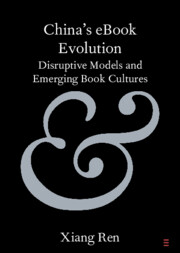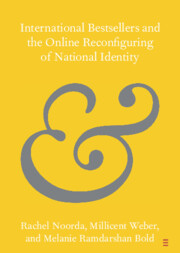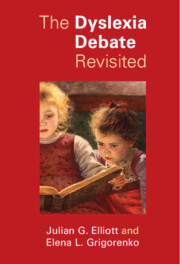252 results
45 - The Pleasures of Reading Camp
- from How to Recognize the Queer Past before (and during) the Advent of Medicalization
-
-
- Book:
- The Cambridge History of Queer American Literature
- Published online:
- 17 May 2024
- Print publication:
- 06 June 2024, pp 801-817
-
- Chapter
- Export citation
Chapter 36 - Goethe Out of Context
- from Part VI - Goethe’s Lasting Significance
-
-
- Book:
- Goethe in Context
- Published online:
- 16 May 2024
- Print publication:
- 23 May 2024, pp 350-359
-
- Chapter
- Export citation

China's eBook Evolution
- Disruptive Models and Emerging Book Cultures
-
- Published online:
- 23 May 2024
- Print publication:
- 13 June 2024
-
- Element
- Export citation

International Bestsellers and the Online Reconfiguring of National Identity
-
- Published online:
- 03 May 2024
- Print publication:
- 23 May 2024
-
- Element
- Export citation
The word frequency effect in first- and second-language reading by Chinese and Dutch bilinguals
-
- Journal:
- Bilingualism: Language and Cognition , First View
- Published online by Cambridge University Press:
- 03 May 2024, pp. 1-16
-
- Article
-
- You have access
- Open access
- HTML
- Export citation
The role of linguistic factors in the retention of verbatim information in reading: An eye-tracking study on L1 and L2 German
-
- Journal:
- Applied Psycholinguistics , First View
- Published online by Cambridge University Press:
- 24 April 2024, pp. 1-25
-
- Article
-
- You have access
- Open access
- HTML
- Export citation

The Dyslexia Debate Revisited
-
- Published online:
- 30 March 2024
- Print publication:
- 18 April 2024
6 - Processing and Understanding Discourse Relations and Connectives
-
- Book:
- Connectives and Discourse Relations
- Published online:
- 22 February 2024
- Print publication:
- 29 February 2024, pp 116-141
-
- Chapter
- Export citation
Chapter 5 - Sanskrit on Shagreen
- from Part II - Aesthetic Conventions
-
- Book:
- Colonialism, World Literature, and the Making of the Modern Culture of Letters
- Published online:
- 19 January 2024
- Print publication:
- 08 February 2024, pp 174-200
-
- Chapter
- Export citation
Chapter 1 - Ethnographic Recension
- from Part I - Epistemic Habits
-
- Book:
- Colonialism, World Literature, and the Making of the Modern Culture of Letters
- Published online:
- 19 January 2024
- Print publication:
- 08 February 2024, pp 53-81
-
- Chapter
- Export citation
Chapter 1 - The Psychology of Reading
-
- Book:
- The Psychology of Reading
- Published online:
- 04 January 2024
- Print publication:
- 18 January 2024, pp 1-20
-
- Chapter
- Export citation
Chapter 7 - Translating Chronic Pain and the Ethics of Reading in the Personal Essay
- from Part II - Developments: Forms
-
-
- Book:
- Literature and Medicine
- Published online:
- 17 January 2024
- Print publication:
- 18 January 2024, pp 120-136
-
- Chapter
- Export citation

The Psychology of Reading
- Insights from Chinese
-
- Published online:
- 04 January 2024
- Print publication:
- 18 January 2024
16 - Print Culture and Literary Sociology
- from Part IV - Critical Approaches
-
-
- Book:
- The Cambridge Companion to Contemporary African American Literature
- Published online:
- 14 December 2023
- Print publication:
- 21 December 2023, pp 268-282
-
- Chapter
- Export citation
13 - How can I incorporate literacy skills in the target language?
- from Part III - Teaching the Skills
-
- Book:
- The Art and Science of Language Teaching
- Published online:
- 21 December 2023
- Print publication:
- 21 December 2023, pp 182-198
-
- Chapter
- Export citation
2 - How do I maximize input in the second language?
- from Part I - Teacher and Student Talk
-
- Book:
- The Art and Science of Language Teaching
- Published online:
- 21 December 2023
- Print publication:
- 21 December 2023, pp 22-33
-
- Chapter
- Export citation
Chapter 2 - Proxemics (Proust)
-
- Book:
- Alone with Others
- Published online:
- 26 October 2023
- Print publication:
- 09 November 2023, pp 37-62
-
- Chapter
- Export citation
12 - Words Thrown Out
- from Part VI - Intellectual Superstars
-
-
- Book:
- Victorian Engagements with the Bible and Antiquity
- Published online:
- 28 September 2023
- Print publication:
- 12 October 2023, pp 311-357
-
- Chapter
- Export citation
6 - Fantastic Communities and Common Ground
-
- Book:
- An Introduction to Fantasy
- Published online:
- 07 October 2023
- Print publication:
- 07 September 2023, pp 374-431
-
- Chapter
- Export citation
Chapter 16 - Comics in Libraries
- from Part III - Uses
-
-
- Book:
- The Cambridge Companion to Comics
- Published online:
- 17 August 2023
- Print publication:
- 31 August 2023, pp 327-345
-
- Chapter
- Export citation



